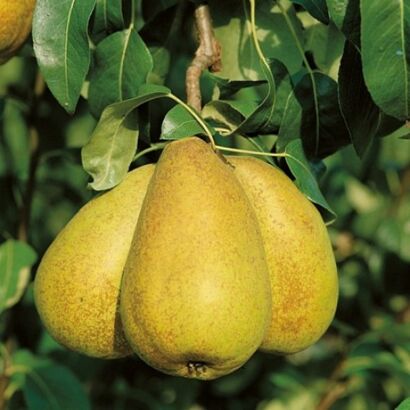Pear April
Variety: semi-wild, partially self-fertile
Fruits: 90 gr., yellow
Maturation: Late winter
Yield: high
Zoning: Siberia, Urals, Altai
| Shipping and pickup: | бронирование на сентябрь/октябрь 2022 года |
| Selection | Russia |
| planting material | Pear |
Aprilka variety belongs to semi-wild, late-winter pear varieties. For its breeding, the gene pool of Chizhovskaya, Bere Ligel and Lada was used. Advantages of the variety: early maturity, winter hardiness up to -40 ° C, excellent keeping quality of fruits.
Characteristics of the variety
Tree medium height, with a wide crown. A powerful root system goes deep into the soil, which increases the winter hardiness of the plant.
Fruits rounded, medium-sized, weighing about 90 gr. The color of a ripe pear is yellow, the taste – sweet and sour.
HarvestApril begins to give 3-4 years after planting the tree. Blooms in May-June. The fruits are harvested in autumn before the onset of cold weather – unripe, hard and tasteless. Pears ripen indoors, by spring they become yellow, juicy, sweet.
Immunityto pests and diseases is average. The most dangerous scab. In order to prevent infection, in autumn it is necessary to carry out sanitary cleaning around the trees, collect and burn fallen leaves, rotten fruits, spray the tree with preventive preparations.
Growing conditions. Variety "April" withstands low temperatures up to –40°C. The tree bears fruit in any weather and is unpretentious in care. Therefore, the pear is ideal for growing in cold climates and areas of risky farming. The culture is popular with gardeners in Altai, the Urals, and Siberia.
"April" refers to partially self-fertile varieties. An increase in its yield will be facilitated by cross-pollination with simultaneously flowering apple and pear trees. Trees must grow in the neighborhood, within a radius of no more than 15 meters. In cold weather, pollinating insects stop their work, in this case the variety is pollinated by hand.
Preparations
| Phase | Operation | Biopreparations | Comment |
|---|---|---|---|
| Pre-plant tillage | Disease treatment | SBT-Trichodermin TH82 | Fight against overwintering forms of pathogens 30-100 g/20 l of water per 1 weave |
| Pest control | SBT-Pecilomycin RM116 | wireworms. Soil pest control: larvae and adults of the May beetle, wireworm, mole cricket, etc. 100-150 g / 1 weave is applied by spreading |
|
| top dressing | SBT-Ekosoil | Stimulation of biological activity 50 g per 20 l of water / 1 weave |
|
| Organic fertilizer "TOR" | Main application in April Proportion 1:20 |
||
| root formation | Disease treatment | SBT-Fitolek BS26 | Soaking the roots of seedlings Prevention of the development of a wide range of fungal diseases 60 g/10 l for 50 pcs. seedlings |
| SBT-Trichodermin TH82 | Prevention of the development of a wide range of fungal diseases. Soaking the roots of seedlings 60 g/10 l for 50 pcs |
||
| Bloom | Disease treatment | SBT-Fitolek BS26 | Processing in the budding phase Prevention of powdery mildew, alternariosis, anthracnose, fomopsis, gray mold, curliness, septoria, tuberculariasis 40 g / 10 l per 1 weave |
| SBT-Trichodermin TH82 | Prevention of late blight, powdery mildew, root rot, gray mold, leaf spot 40 g/10 l per 100 m2 |
||
| Pest control | SBT-Actaro E | Processing in the budding phase Control of pests weevils, bronzovka, mites, aphids, sawflies. 10 g/10 l per 1 weave |
|
| top dressing | SBT-Biocomplex Amino | Stimulation of plant growth. Improvement of photosynthetic activity 20–30 ml/10 l per 1 hectare |
|
| Fruiting | Disease treatment | SBT-Fitolek BS26 | Prevention of powdery mildew, alternariosis, scab, gray mold, monilial and bacterial burns, clasterosporiasis, cytosporiasis, infectious drying of branches, bacterial cancer. During the period of fruit formation (3-4 treatments) at intervals of 20-25 days 40 g / 10 l per 1 weave 10-15 days before harvesting 40 g / 10 l per 1 weave |
| SBT-Trichodermin TH82 | During the period of fruit formation (3-4 treatments) at intervals of 20-25 days 40 g/10 l per 1 weave |
||
| After harvest | Disease treatment | SBT-Trichodermin TH82 | Autumn processing Reducing the stock of overwintering forms of pathogens spraying 120 g per 10–15 liters per 1 weave |
